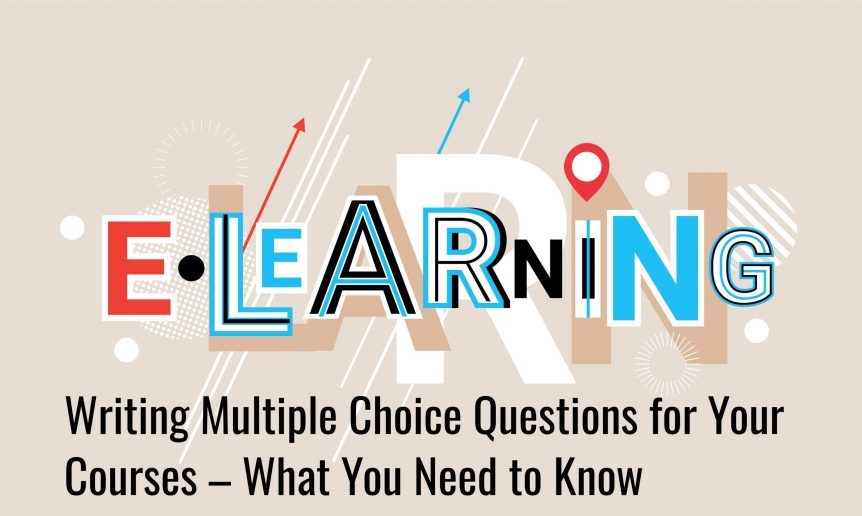Writing Multiple Choice Questions for Your E-Learning Courses – What You Need to Know
Quizzes are an essential part of most e-learning courses. They help assess the capabilities of learners, they can show learners areas for improvement, and they can enhance the learning experience. To create a quiz, you need to write questions. There are lots of different question types that you can use, but one of the most popular is the multiple-choice question.
Multiple-choice questions are often criticised because they are said to be too easy, not least because they give learners an opportunity to guess the answer. However, when you write good multiple-choice questions, you can improve your quizzes and e-learning courses overall. In fact, multiple-choice questions are one of the most useful types of questions you can use.
The Structure of a Multiple-Choice Question
A multiple-choice question has three parts:
- The stem, which is the main question part of the multiple-choice question.
- The correct answer.
- The incorrect alternatives.
The correct answer is self-explanatory, but the stem and incorrect alternatives deserve further exploration. Specifically, there are best practices that will help you optimise the stems and incorrect alternatives that you use in your multiple-choice questions.
Optimising the Stem in Multiple-Choice Questions
- Make sure the stem clearly defines the problem without any ambiguity, avoiding situations where the learner has to figure out the meaning of the question before they can work on the answer.
- Don’t include irrelevant content in the stem. In almost all cases, the stem should be a single, short sentence.
- Try to avoid creating fill-in-the-blank multiple-choice questions, where you give the learner a partial sentence. Full questions are much more effective.
Optimising Incorrect Alternatives in Multiple-Choice Questions
- Make sure the incorrect alternatives you include are plausible. You should aim to make the incorrect alternatives a distraction for learners, causing them to stop and think.
- A good way to come up with plausible incorrect alternatives is to use the most commonly given incorrect answers to the question.
- While your incorrect alternatives should be distractions, they shouldn’t appear as tricks. Learners will lose trust in the quiz if they think the questions are there to trick them.
- Avoid giving hints to the correct answer when writing your incorrect alternatives.
- Present the incorrect alternatives in a similar style to the correct answer, using the same language and keeping them to the same length.
- The number of incorrect alternatives in the question is not as relevant as ensuring they are all plausible. That said, four is usually the norm.
- List the correct answer and the incorrect alternatives in a logical order to prevent any bias from creeping in. Alphabetically is often a good approach.
One additional tip concerns the use of “All of the above” and “None of the above” as incorrect alternatives. Both these options make it easier for learners to guess the answer, so they should be avoided.
For example, it is easier for learners to guess the answer with “All of the above” as an option if they can identify two. In other words, they don’t need to know it is “all of the above”. They only need to know it is more than one of the above. The same applies to “None of the above”. For savvy learners, identifying two is enough to check the “None of the above” box.
Benefits of Multiple-Choice Questions in E-Learning
- Free from bias – this point particularly applies when compared to a short answer question where the learner writes a sentence or two. Assessing that answer is a subjective exercise, whereas with multiple choice questions, assessments are objective, i.e., the learner either selected the correct option or they didn’t.
- Versatile – multiple-choice questions can be used in a range of situations, including knowledge recall and more complex analytical situations.
- Comprehensive – learners can answer multiple-choice questions faster than they can answer other types of questions. As a result, you can include more questions in your quiz, covering a wider and more comprehensive range of topics.
- Reliable – multiple-choice questions, particularly well-written and constructed multiple-choice questions, are more reliable than other question types, including true/false questions. With true/false questions, the learner has a 50 percent chance of answering correctly, even if they have no idea of the right answer. Guessing a well written multiple-choice question is much harder.
Additional Tips for Writing Multiple Choice Questions
- When creating multiple-choice questions, don’t simply test the ability to remember information. These types of questions provide little value as they don’t demonstrate a proper understanding of the topic. The better approach is to create multiple-choice questions that test critical thinking and encourage the learner to assess and analyse.
- Don’t make the question and possible options too easy to guess.
- Try to avoid negatively worded questions as they are more difficult to understand. So, for example, instead of asking what you shouldn’t do in a particular situation, ask what you should do.
- Keep the text of the correct answer and incorrect alternatives as short as possible by including as much of the information as you can in the question itself.
- Check the question to ensure it is clear, easy to understand, and free from spelling and grammatical errors.
- Avoid giving away the answer to a multiple-choice question in another one.
Writing Questions that Enhance the Learning Experience
Multiple-choice questions in e-learning quizzes have an assessment purpose, but you should also remember they are a part of the learning process. In fact, when properly written, multiple-choice questions are an important part of the learning process and can enhance the learning experience. Therefore, it makes sense to spend time making them as good as possible.
